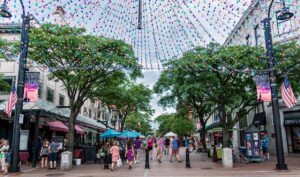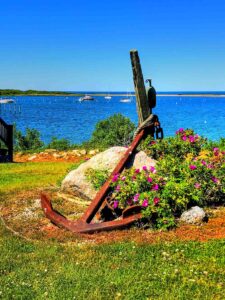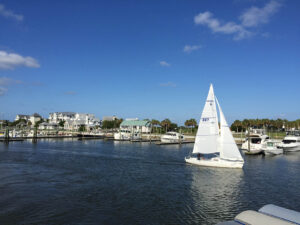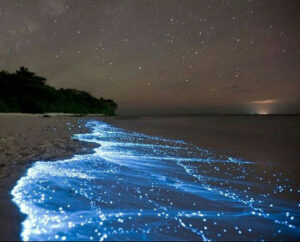The Spanish expeditions of discovery and conquest of the New World always had a patina of religious fervor to them. The conquistadors were devout Catholics and their armies were accompanied by priests, but it was gold and silver that they worshipped.
The Spaniards had a penchant for naming their discoveries based on the Catholic pantheon of saints or the holy days of their calendar. When Juan Ponce de Leon sighted land east of the Bahamas in 1513, he named it La Florida, as it was Easter season and a holiday known as Pascua Florida was being celebrated back in Seville.
Pearls, gems, silver, gold, sugar, spices and lumber from North and South America made Spain the wealthiest country in Europe. The value of riches that sailed into Spain’s ports each year was staggering. In today’s dollars, the Spanish crown valued these New World treasures at $600 million for the year 1550 alone— within 50 years, it more than quadrupled to $2.5 billion per year.
These riches did not go unnoticed by other monarchies, particularly those in France and England. In 1555, the French sacked and burned Havana, Cuba, the consolidation and departure port for all treasure galleons returning to Spain since Columbus’s time. In response to this looting, King Phillip II of Spain devised a convoy system to bring the remaining wealth of of the Maya and Inca Empires back to his country and appointed Pedro Menendez de Aviles as Captain general of the Fleet of the Indies to oversee this enterprise.
Several years later, the Wars of Religion ignited across France, claiming the lives of between 2 million and 4 million Catholics and the Protestants known as Huguenots. In 1564, a Huguenot explorer led a group of 200 French settlers to the mouth of the St. Johns river in Spanish Florida and established Fort Caroline near present day Jacksonville. The colonists were befriended by the local Timicua tribe, and rather than become self-sufficient, the colony relied on the Timicua for food. Some of the settlers complained about the hard labor necessary to make their pioneering venture a success, and within a year a group of them deserted, commandeered a ship and sailed to the Gulf of Mexico to raid the riches-filled Spanish galleons.
Those Protestant French pirates, who first squatted in Catholic spanish Florida and now preyed on Spanish ships, were too much for the Spanish king. Not only were these brigands heretics, they endangered the passage of the Fleet of the indies. The pirates and Fort Caroline had to be eliminated.
In 1565, the king of Spain sent a force to destroy the French settlement of Fort Caroline, with Menendez as admiral of the mission. Menendez landed 30 miles south of Fort Caroline on Florida’s east coast on August 28th, the feast day of St. Augustine of Hippo, and named the inlet and surrounding territory san Agustin in honor of the fourth-century theologian and philosopher.
As soon as supplies were unloaded from his ships and a rough fortification built, Menendez marched his troops north and surprised the defenders of Fort Caroline with a dawn raid. The defenders were easily overwhelmed and killed. Their bodies were then hung from trees with a sign inscribed, “Hanged, not as Frenchmen, but as heretics.”
At the same time the Spanish had marched on Fort Caroline, a group of French soldiers sailed from that fort to attack the newly established St. Augustine. Strong tropical storms hampered their ship’s ability to maneuver, and the soldiers were shipwrecked slightly south of St. Augustine. A Spanish patrol soon found the survivors and the Frenchmen surrendered. But Menendez executed them forthwith, and the inlet where this massacre occurred is now known by the name Matanzas, Spanish for “killings.”
These days, Matanzas Inlet is also a little dicey for boaters. small skiffs, tenders and personal watercraft are about all that can safely navigate its shoal waters, and local knowledge is worth seeking out. To the north, the red-and-white striped safe-water buoy at the entrance to St. Augustine inlet leads to a safe passage for yachts. But due to the constant shifting sands, cruisers entering this inlet should navigate with prudence, especially when wind and current oppose each other. Again, seeking local knowledge is advisable. Make your dock reservation at the Municipal Marina in the shadow of the recently renovated Bridge of Lions, or at Camachee Cove Yacht Harbor.
Today, St. Augustine is recognized as the oldest continuously occupied European settlement in the United States. There are two major historic sites in the city that reflect its Spanish heritage: the Castillo de San Marcos, the oldest masonry fortress in the continental U.S., and the Cathedral Basilica, which celebrates the first Catholic parish on U.S. soil. History abounds in this city, but one need not look back only to the European colonization. In more recent times, the 1880s, Henry Flagler changed the face of St. Augustine by developing it into a winter resort for wealthy northerners. Then it was Martin Luther King Jr., in 1964, who worked to break the color line and made St. Augustine a pivotal city for peaceful protests during the civil rights movement.
Looking for dockage in St. Augustine?
Marinalife recommends Camachee Cove Yacht Harbor (904-829-5676, camacheeisland.com). The marina can accommodate vessels up to 135 feet with amenities including boaters lounges, swimming pool, WiFi, courtesy cars, shower and laundry facilities. Cruising Club Members receive 10¢ off per gallon of fuel and 10% off transient dockage.
Capt. Jeff Werner has been in the yachting industry for over 25 years. In addition to working as a captain on private and charter yachts, both sail and power, he is a certified instructor for the USCG, US Sailing, RYA and the MCA. He is also the Diesel Doctor, helping to keep your yacht’s fuel in optimal condition for peak performance. For more information, call 239-246-6810, or visit MyDieselDoctor.com. All Marinalife members receive a 10% discount on purchases of equipment, products and supplies from Diesel Doctor.





